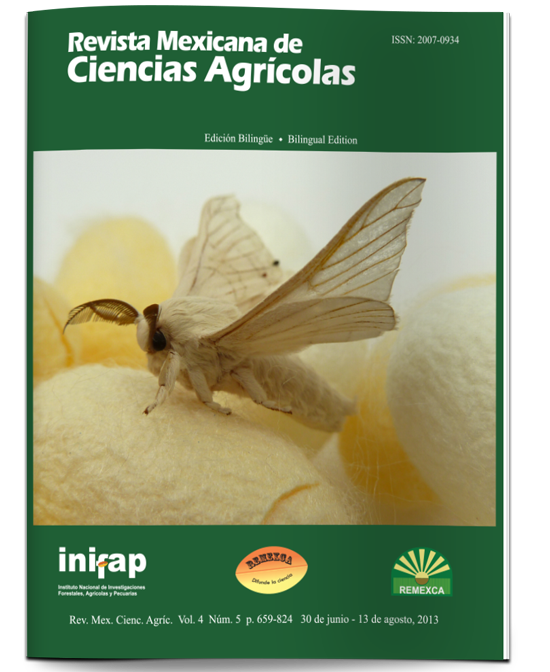The relationship between the reaction to common blight and the yield and seed weight of irrigated and rainfed beans
DOI:
https://doi.org/10.29312/remexca.v4i5.1167Keywords:
Phaseolus vulgaris, Xanthomonas campestris pv. phaseoli, disease resistanceAbstract
Various diseases damage the bean crops in the central region of Mexico, especially those under rainfed conditions. The aim of this study was to identify bean genotypes tolerant to common blight (Xanthomonas campestris pv. phaseoli), and to determine the association between the reaction to this disease and yield and seed weight in 36 genotypes established under irrigation and rainfed conditions. From 2004 to 2006, an assay was established five times in Celaya, Guanajuato, with 36 genotypes of different origin and type of grain; two were conducted under irrigated conditions in February sowings, and three under rainfed conditions in July sowings. We determined the reaction of the genotypes to common blight incidence, their yield and the weight of 100 seeds of them. Overall, common blight incidence was observed in both planting systems at the beginning of the reproductive stage, intensifying, with differences between genotypes (p< 0.05), towards grain filling; the incidence was higher under rainfed irrigation. All genotypes showed, in varying degrees, disease symptoms on the leaves, and a few of them on the pods. No immune genotypes were observed; the ones with the lowest incidence of the disease, as shown in the assays, were: Afn, FEB 190, A 321 (reaction 2.3), Flor de Mayo Anita, PT 98001 (2.6), Alteño 2000, A 339, EMP507 and Flor de Mayo M38 (2.7). There was no relationship between the incidence of the disease and yield, but there was a relationship between the disease incidence and the weight of 100 seeds; this due to the susceptibility of the "pinto" and "bayo" genotypes with medium to large size seeds of the Durango race.
Downloads
Downloads
Published
How to Cite
Issue
Section
License
The authors who publish in Revista Mexicana de Ciencias Agrícolas accept the following conditions:
In accordance with copyright laws, Revista Mexicana de Ciencias Agrícolas recognizes and respects the authors’ moral right and ownership of property rights which will be transferred to the journal for dissemination in open access. Invariably, all the authors have to sign a letter of transfer of property rights and of originality of the article to Instituto Nacional de Investigaciones Forestales, Agrícolas y Pecuarias (INIFAP) [National Institute of Forestry, Agricultural and Livestock Research]. The author(s) must pay a fee for the reception of articles before proceeding to editorial review.
All the texts published by Revista Mexicana de Ciencias Agrícolas —with no exception— are distributed under a Creative Commons License Attribution-NonCommercial 4.0 International (CC BY-NC 4.0), which allows third parties to use the publication as long as the work’s authorship and its first publication in this journal are mentioned.
The author(s) can enter into independent and additional contractual agreements for the nonexclusive distribution of the version of the article published in Revista Mexicana de Ciencias Agrícolas (for example include it into an institutional repository or publish it in a book) as long as it is clearly and explicitly indicated that the work was published for the first time in Revista Mexicana de Ciencias Agrícolas.
For all the above, the authors shall send the Letter-transfer of Property Rights for the first publication duly filled in and signed by the author(s). This form must be sent as a PDF file to: revista_atm@yahoo.com.mx; cienciasagricola@inifap.gob.mx; remexca2017@gmail.
This work is licensed under a Creative Commons Attribution-Noncommercial 4.0 International license.



